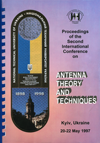Maximum efficiency of a beamed microwave power transmission at the presence of fluctuations of the transmitting antenna illumination
DOI:
https://doi.org/10.1109/ICATT.1997.1235239Abstract
A microwave power transmission system (PTS) consist of a transmitting antenna, free space and a receiving antenna-rectenna. The efficiency of PTS is characterized by the efficiency factor of power transmission system (EFPTS). This parameter depend on sizes of transmitting and receiving antenna apertures, distance between them, mutual orientation, aperture distribution of the transmitting antenna, and parameters of rectifying elements, the effect of which on EFPTS has been investigated rather completely. However a number of factors exist that can affect EFPTS, namely: amplitude and phase fluctuations of transmitting antenna illumination. As these factors are always present in real systems, they should be taken into account during designing the latter. In this article, optimization of PTS by the criterion of the maximum of mean efficiency factor (MEF) of PTS is carried out.References
Shifrin, Y.S. Statistical Antenna Theory. Boulder: Golem Press, 1971.
Published
1997-05-24
Issue
Section
Microwave technologies application

